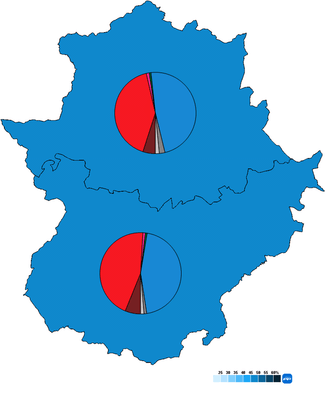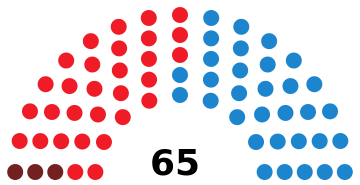Extremaduran parliamentary election, 2011
.svg.png)
|
|
|
|
All 65 seats in the Assembly of Extremadura
33 seats needed for a majority |
| Opinion polls |
| Registered |
906,551  1.5% 1.5% |
| Turnout |
676,768 (74.7%)
 0.3 pp 0.3 pp |
| |
First party |
Second party |
Third party |
| |
.jpg) |
_(Recortada).jpg) |
 |
| Leader |
José Antonio Monago |
Guillermo Fernández Vara |
Pedro Escobar |
| Party |
PP |
PSOE |
IU |
| Leader since |
8 November 2008 |
20 September 2006 |
30 September 2007 |
| Last election |
27 seats, 38.7% |
38 seats, 53.0% |
0 seats, 4.5% |
| Seats won |
32 |
30 |
3 |
| Seat change |
 5 5 |
 8 8 |
 3 3 |
| Popular vote |
307,975 |
290,045 |
38,157 |
| Percentage |
46.1% |
43.4% |
5.7% |
| Swing |
 7.4 pp 7.4 pp |
 9.6 pp 9.6 pp |
 1.2 pp 1.2 pp |
|
|
|
The 2011 Extremaduran parliamentary election was held on Sunday, 22 May 2011, to elect the 8th Assembly of Extremadura, the unicameral regional legislature of the Spanish autonomous community of Extremadura. At stake were all 65 seats in the Assembly, determining the President of Extremadura.
For the first time since the first democratic election in 1983 in the region, the People's Party (PP) was able to win a regional election, obtaining its best historical result, with 46.1% of the share and 32 seats. The Spanish Socialist Workers' Party (PSOE), which had formed the government of the Extremaduran region since 1983, achieving an absolute majority of seats at every election except in 1995, was ousted from power in the worst result obtained by the party until that time.[1]
However, as the PP stood one seat short of an overall majority, the possibility arose of PSOE pact with United Left (IU), which had re-entered the Assembly after a four-year absence, in order to maintain the regional government.[2] However, IU declined to support outgoing Socialist Guillermo Fernández Vara after a 24-year PSOE rule over the region, opting to abstain in the investiture voting and allowing the most-voted candidate to be elected. As a result of the PP having more seats than the PSOE, party candidate José Antonio Monago became the first not-Socialist democratically-elected President of the region.[3]
Electoral system
The number of seats in the Extremaduran Assembly was set to a fixed-number of 65. All Assembly members were elected in 2 multi-member districts, corresponding to Extremadura's two provinces, using the D'Hondt method and a closed-list proportional representation system. Each district was entitled to an initial minimum of 20 seats, with the remaining 25 seats allocated among the two provinces in proportion to their populations. For the 2011 election, seats were distributed as follows: Badajoz (36) and Cáceres (29).
Voting was on the basis of universal suffrage in a secret ballot. Only lists polling above 5% of valid votes in each district (which include blank ballots—for none of the above) were entitled to enter the seat distribution. Alternatively, however, if a party did not reach the 5% threshold in a district, it could enter the seat distribution on the following conditions:
- 1. That the party had stood in both districts.
- 2. That, regionally, the party had reached the 5% threshold (even if it did not reach it in one of the two districts).[4]
Opinion polls
Vote
Poll results are listed in the table below in reverse chronological order, showing the most recent first. The highest percentage figure in each polling survey is displayed in bold, and the background shaded in the leading party's colour. In the instance that there is a tie, then no figure is shaded. The lead column on the right shows the percentage-point difference between the two parties with the highest figures. Poll results use the date the survey's fieldwork was done, as opposed to the date of publication. However, if such date is unknown, the date of publication will be given instead.
Seat projections
Opinion polls showing seat projections are displayed in the table below. The highest seat figures in each polling survey have their background shaded in the leading party's colour. In the instance that there is a tie, then no figure is shaded. 33 seats were required for an absolute majority in the Extremaduran Assembly.
Results
Overall
← Summary of the 22 May 2011 Extremaduran Assembly election results →
| |
| Party |
Vote |
Seats |
| Votes |
% |
±pp |
Won |
+/− |
|
People's Party-United Extremadura (PP-EU) |
307,975 | 46.13 |  7.42 7.42 |
32 |  5 5 |
|
Spanish Socialist Workers' Party-Regionalists (PSOE-Regionalistas) |
290,045 | 43.45 |  9.55 9.55 |
30 |  8 8 |
|
United Left-Independent Socialists of Extremadura (IU-SIEx) |
38,157 | 5.72 |  1.20 1.20 |
3 |  3 3 |
| |
|
Union, Progress and Democracy (UPyD) |
7,058 | 1.06 | New |
0 | ±0 |
|
Independents for Extremadura (IPEx) |
4,659 | 0.70 |  0.56 0.56 |
0 | ±0 |
|
Ecolo-The Greens (ECOLO-LV) |
3,887 | 0.58 |  0.03 0.03 |
0 | ±0 |
|
Extremaduran People's Union (UPEx) |
2,185 | 0.33 |  0.10 0.10 |
0 | ±0 |
|
For a Fairer World (PUM+J) |
1,573 | 0.24 | New |
0 | ±0 |
|
Convergence for Extremadura (CEX) |
1,056 | 0.16 | New |
0 | ±0 |
|
Communist Party of the Peoples of Spain (PCPE) |
836 | 0.13 |  0.01 0.01 |
0 | ±0 |
|
Citizens for Blank Votes (CenB) |
774 | 0.12 |  0.04 0.04 |
0 | ±0 |
|
Blank ballots |
9,394 | 1.41 |  0.22 0.22 |
|
| |
| Total |
667,599 | 100.00 | |
65 | ±0 |
| |
| Valid votes |
667,599 | 98.65 |  0.62 0.62 |
|
| Invalid votes |
9,169 | 1.35 |  0.62 0.62 |
| Votes cast / turnout |
676,768 | 74.65 |  0.30 0.30 |
| Abstentions |
229,783 | 25.35 |  0.30 0.30 |
| Registered voters |
906,551 | |
| |
| Source: Argos Information Portal |
| Vote share |
|---|
|
|
|
|
|
| PP-EU |
|
46.13% |
| PSOE-Regionalistas |
|
43.45% |
| IU-SIEx |
|
5.72% |
| UPyD |
|
1.06% |
| Others |
|
2.24% |
| Blank ballots |
|
1.41% |
| Parliamentary seats |
|---|
|
|
|
|
|
| PP-EU |
|
49.23% |
| PSOE-Regionalistas |
|
46.15% |
| IU-SIEx |
|
4.62% |
Results by province

Election results by province.
| Badajoz |
| Party |
Vote |
Seats |
| Votes |
% |
±pp |
Won |
+/− |
|
People's Party-United Extremadura (PP-EU) |
184,503 | 45.00 |  7.28 7.28 |
17 |  3 3 |
|
Spanish Socialist Workers' Party-Regionalists (PSOE-Regionalistas) |
183,384 | 44.73 |  9.07 9.07 |
17 |  4 4 |
|
United Left-Independent Socialists of Extremadura (IU-SIEx) |
25,331 | 6.18 |  1.20 1.20 |
2 |  2 2 |
| |
|
Union, Progress and Democracy (UPyD) |
4,052 | 0.99 | New |
0 | ±0 |
|
Independents for Extremadura (IPEx) |
2,837 | 0.69 |  0.66 0.66 |
0 | ±0 |
|
Ecolo-The Greens (ECOLO-LV) |
2,022 | 0.49 |  0.10 0.10 |
0 | ±0 |
|
For a Fairer World (PUM+J) |
1,063 | 0.26 | New |
0 | ±0 |
|
Communist Party of the Peoples of Spain (PCPE) |
836 | 0.20 |  0.02 0.02 |
0 | ±0 |
|
Convergence for Extremadura (CEX) |
537 | 0.13 | New |
0 | ±0 |
|
Blank ballots |
5,452 | 1.33 |  0.16 0.16 |
|
| |
| Total |
410,017 | 100.00 | |
36 |  1 1 |
| |
| Valid votes |
410,017 | 98.82 |  0.48 0.48 |
|
| Invalid votes |
4,909 | 1.18 |  0.48 0.48 |
| Votes cast / turnout |
414,926 | 74.70 |  0.16 0.16 |
| Abstentions |
140,521 | 25.30 |  0.16 0.16 |
| Registered voters |
555,447 | |
| |
| Source: Argos Information Portal |
|
| Caceres |
| Party |
Vote |
Seats |
| Votes |
% |
±pp |
Won |
+/− |
|
People's Party-United Extremadura (PP-EU) |
123,472 | 47.94 |  7.70 7.70 |
15 |  2 2 |
|
Spanish Socialist Workers' Party-Regionalists (PSOE-Regionalistas) |
106,661 | 41.41 |  10.34 10.34 |
13 |  4 4 |
| |
|
United Left-Independent Socialists of Extremadura (IU-SIEx) |
12,826 | 4.98 |  1.11 1.11 |
1 |  1 1 |
|
Union, Progress and Democracy (UPyD) |
3,006 | 1.17 | New |
0 | ±0 |
|
Extremaduran People's Union (UPEx) |
2,185 | 0.85 |  0.27 0.27 |
0 | ±0 |
|
Ecolo-The Greens (ECOLO-LV) |
1,865 | 0.72 |  0.06 0.06 |
0 | ±0 |
|
Independents for Extremadura (IPEx) |
1,822 | 0.71 |  0.41 0.41 |
0 | ±0 |
|
Citizens for Blank Votes (CenB) |
774 | 0.30 |  0.11 0.11 |
0 | ±0 |
|
Convergence for Extremadura (CEX) |
519 | 0.20 | New |
0 | ±0 |
|
For a Fairer World (PUM+J) |
510 | 0.20 | New |
0 | ±0 |
|
Blank ballots |
3,942 | 1.53 |  0.30 0.30 |
|
| |
| Total |
257,582 | 100.00 | |
29 |  1 1 |
| |
| Valid votes |
257,582 | 98.37 |  0.84 0.84 |
|
| Invalid votes |
4,260 | 1.63 |  0.84 0.84 |
| Votes cast / turnout |
261,842 | 74.58 |  1.02 1.02 |
| Abstentions |
89,262 | 25.42 |  1.02 1.02 |
| Registered voters |
351,104 | |
| |
| Source: Argos Information Portal |
|
Notes
- 1 2 This survey shows its poll results projected over candidacy votes (that is, votes going for political parties, excluding blank ballots). The vote percentage in the official election is calculated including blank ballots into the estimation. In order to obtain data comparable to both the official results as well as those of other surveys, a rule of three has been applied to the survey projections, with the results of the calculation being shown instead.
References

.jpg)
_(Recortada).jpg)
